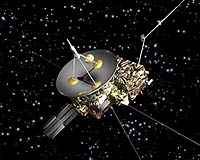 |
Heidelberg, Germany (SPX) Dec 16, 2009 The first paper on proton collisions in the CERN Large Hadron Collider (LHC) - designed to provide the highest energy ever explored with particle accelerators - is published online this week in Springer's European Physical Journal C. On 23 November 2009, during the early commissioning of the CERN (European Organization for Nuclear Research) LHC - which was built in the circular tunnel of 27km circumference previously used by the Large Electron-Positron collider (LEP) - two counter-rotating proton bunches were circulated concurrently for the first time in the machine, at the LHC injection energy of 450 GeV per beam. A total of 284 collisions were recorded by the ALICE experiment and immediately reconstructed and analyzed. The researchers determined the average number of charged particles emitted perpendicular to the beam direction, known as 'pseudorapidity density'. Their aim was to compare their results with previous measurements of proton-antiproton collisions at the same energy, and to establish a reference for comparison with future measurements at higher LHC energies. The paper by the ALICE collaboration, which brings together authors from 113 research institutes, describes the experimental conditions in detail, as well as the main features of the ALICE detector systems used for the analysis. The results obtained are consistent with earlier measurements of proton-antiproton interactions at the same energy. They also compare with model calculations. Dr. Jurgen Schukraft from CERN and ALICE spokesperson said: "This important benchmark test illustrates the excellent functioning and rapid progress of the LHC accelerator, and of both the hardware and software of the ALICE experiment, in this early start-up phase. LHC and its experiments have finally entered the phase of physics exploitation." Share This Article With Planet Earth
Related Links ALICE: A Large Ion Collider Experiment Understanding Time and Space
 A 200 Million Mile Long Lab Bench For Turbulence Research
A 200 Million Mile Long Lab Bench For Turbulence ResearchCoventry, UK (SPX) Dec 14, 2009 Physicists working in space plasmas have made clever use of the Ulysses spacecraft and the solar minimum to create a massive virtual lab bench to provide a unique test for the science underlying turbulent flows. Researchers have an ideal mathematical model of turbulence in fluids (ideal because the model is of an infinitely large flow). They also have been able to measure how such ... read more |
|
| The content herein, unless otherwise known to be public domain, are Copyright 1995-2009 - SpaceDaily. AFP and UPI Wire Stories are copyright Agence France-Presse and United Press International. ESA Portal Reports are copyright European Space Agency. All NASA sourced material is public domain. Additional copyrights may apply in whole or part to other bona fide parties. Advertising does not imply endorsement,agreement or approval of any opinions, statements or information provided by SpaceDaily on any Web page published or hosted by SpaceDaily. Privacy Statement |